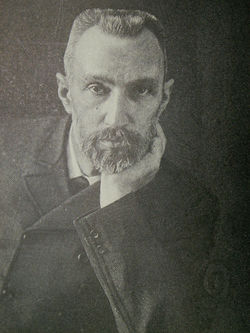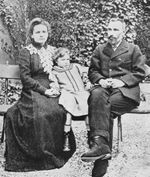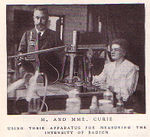Pierre Curie
Pierre Curie (May 1, 1869-April 19, 1906) was a French physicist and chemist who made great progress in areas including crystallography, radioactivity, and piezoelectricity. He worked alongside Henri Becquerel, his wife Marie Curie, and his brother Jacques Curie. His notable achievements include the Curie Scale, the Piezoelectric Quartz Electrometer, and the discovery of polonium and radium. Pierre Curie lived a short forty-six year life before dying in a carriage accident.
Early Life
Pierre Curie, born in Paris May 15th, 1869, was educated at an early age by his father, Eugène, who was a doctor. Young Pierre showed a penchant for mathematics, geometry and science, as demonstrated when he built instruments to aid he and his brother Jacques Curie's research- the Curie Scale, which calculated measurements, and the Piezoelectric Quartz Electrometer, a device for observing distortion in quartz during experiments. Both of these instruments assisted piezoelectricity study later conducted by several scientists, including Maria Skłodowska, the future wife of Pierre.
Curie did not immediately attend school to gain a higher level of education due to lack of money, but instead worked at a laboratory until he was able to enroll at the Faculty of Sciences at the Sorbonne. In 1878, he received his Licentiateship in Physics and continued to work in the laboratory until he gained enough money to continue his research. Curie was introduced to Maria Skłodowska through a friend, and took her on as a student in his own lab while in charge of Physics and Industrial Chemistry Schools. Once he had earned his doctorate of Science and was appointed as a professor of physics, he decided to marry Maria, who became known in France as Marie Curie.[1]
During their marriage, Pierre and Marie Curie had two children, both girls, Irène and Ève. Irène Joliot-Curie, like her parents, studied radiology while Ève Curie wrote a biography on her mother. The couple dedicated their whole lives to teaching to fund their research, often working in laboratories in poor conditions. The two worked seamlessly together, making discoveries together until Pierre's death in a carriage accident April 19th, 1906.[2]
Research
Curie's earliest research included crystallography (the study of atomic and molecular structure) with Jacques and magnetism, testing magnetic properties of several substances under varying conditions. Pierre created the Curie point, the temperature at which objects lose their magnetic properties. [3] He also formulated the Curie Dissymmetry Principle, stating "the impossibility of bringing about a specific physical process in an environment lacking a certain minimal dissymmetry characteristic of the process."[4] He moved to researching radiology with his wife, announcing the discovery of radium and polonium by fractionation of pitchblende in 1898. They continued their research together as they discovered the properties of radium. As his wife researched how to extract pure substances from ores, Pierre and his students studied radiation and nuclear energy of radioactive substances. [4]
Awards
| Awards | |
|---|---|
| 1903 | Membership to the Academy of Sciences and Letters of Cracow |
| 1903 | The Davy medal from the Royal Society of London, shared with Marie Curie[5] |
| 1903 | The Nobel Prize in Physics, shared with Henri Becquerel and Marie Curie[6] |
| 1904 | Membership to the Royal Institution of Great Britain |
| 1904 | The Matteucci Medal[7] |
| 1909 | The Elliott Cresson Medal, awarded posthumously[8] |
References
- ↑ Pierre Curie (1859 - 1906) Atomic Archive. Web. Accessed January 3, 2015.No Author.
- ↑ Pierre Curie-Biographical Nobel Prize. Web. Accessed January 3, 2015. Author unknown.
- ↑ The Editors of Encyclopedia Britannica. Curie Point Encyclopedia Brittanica. Web. Last Updated December 3, 2015.
- ↑ 4.0 4.1 The Editors of Encyclopedia Britannica. Pierre Curie- French Chemist Encyclopedia Britannica. Web. Last Updated October 30, 2015.
- ↑ Award Winners: Davy Medal The Royal Society. Web. Accessed January 13, 2016.
- ↑ The Nobel Prize in Physics 1903 Nobelprize.org. Web. Published 2014. Unknown Author.
- ↑ "Matteucci" Medal Acceademia Nazionale delle Scienze. Web. Accessed January 13, 2016.
- ↑ Pierre Curie The Franklin Institute. Web. Accessed January 13, 2016.



